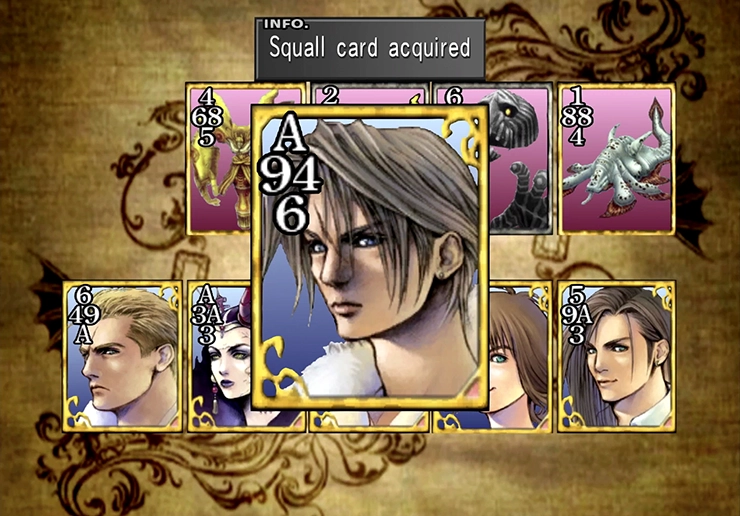Triple Triad is a card game that you can play as you make your way through the game of Final Fantasy VIII. The game operates as a type of side quest that you have the option of completing; that is to say, playing Triple Triad is completely optional, and you can skip over it entirely.
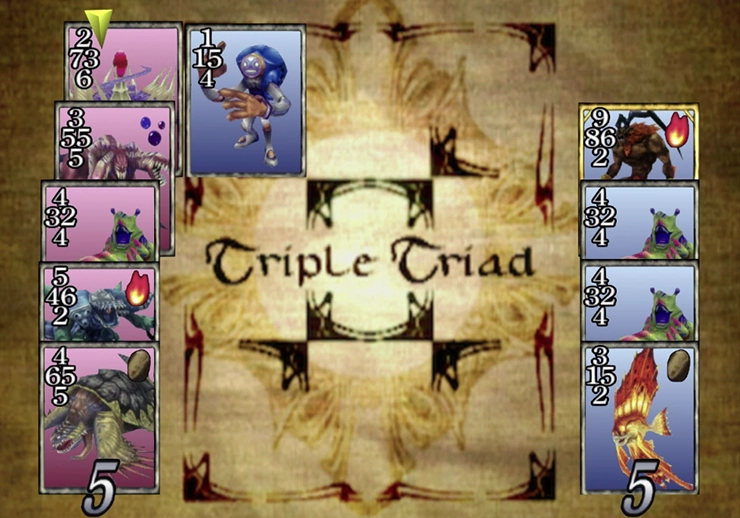
However, for those who wish to play some Triple Triad as they progress through the game, you can use the cards that you win in matches to utilize the “Triple Triad Power-Up Strategy,” so it is generally recommended that you pick up rare cards as you progress through the game.
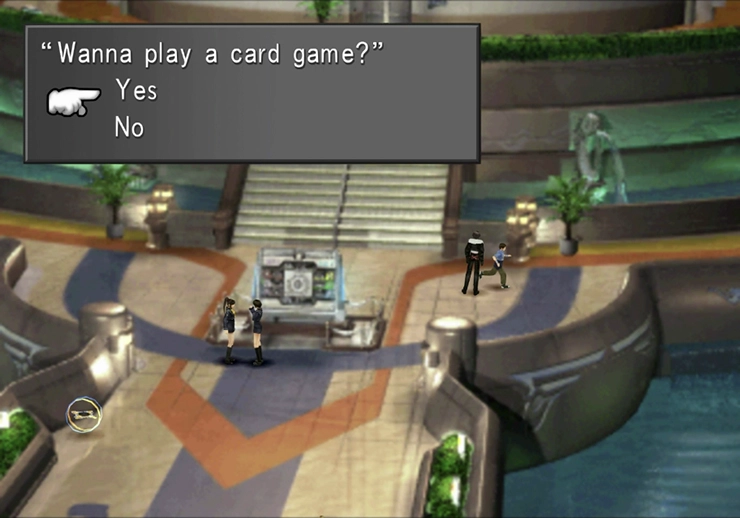
So, how do you play?
Getting Started
The first step is to accumulate enough cards to engage in a match of Triple Triad. You need at least five cards in your inventory to initiate a match, and you will lose cards any time you lose a game, so it’s better to have even more than 5 when you first begin a game.

The three routes for obtaining cards in the early stages of the game:
- The card player on the balcony of 2F in Balamb Garden will give you a small deck of low-level cards that you can get started with. This deck includes a
 Geezard,
Geezard,  Funguar,
Funguar,  Red Bat,
Red Bat,  Gayla,
Gayla,  Gesper,
Gesper,  Fastitocalon-F, and a
Fastitocalon-F, and a  Caterchipillar, which is more than enough to initiate some games.
Caterchipillar, which is more than enough to initiate some games. - Wait until you’ve picked up a few rare cards, such as the
 Ifrit Card, which you receive for free once you have obtained Ifrit by defeating it in the Fire Cavern quite early on in the game.
Ifrit Card, which you receive for free once you have obtained Ifrit by defeating it in the Fire Cavern quite early on in the game. - There’s a small chance that you will obtain an enemy’s card when you defeat them in battle. Alternatively, you can use Quezacotl’s
 Card Mod ability on enemies with low HP to turn them into a Triple Triad card.
Card Mod ability on enemies with low HP to turn them into a Triple Triad card.
Using the jegged.com strategy guide, you should not need to use ![]() Card Mod on any enemies as the starter deck you receive from the Triple Triad player on 2F and the rare cards you can earn early on are more than enough. Just save your game in case you accidentally lose a match or two and reset the game to give yourself another chance to win.
Card Mod on any enemies as the starter deck you receive from the Triple Triad player on 2F and the rare cards you can earn early on are more than enough. Just save your game in case you accidentally lose a match or two and reset the game to give yourself another chance to win.
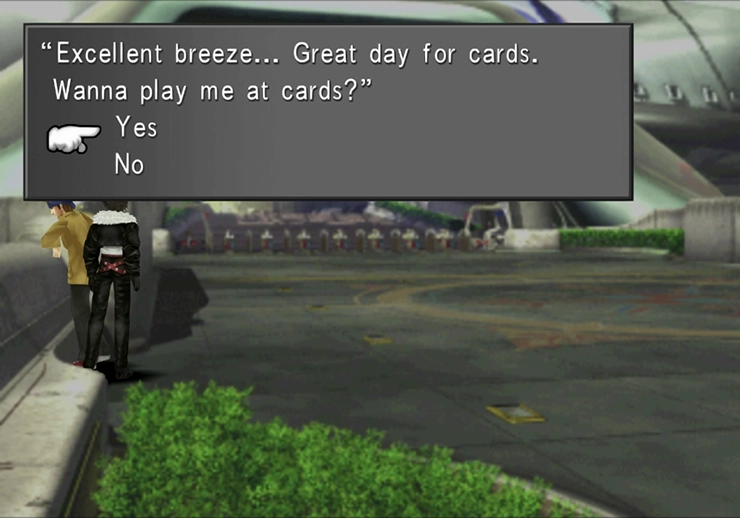
Initiating Matches
Starting up a game of Triple Triad is very easy. Just press the utton when speaking to someone, and if they are a Triple Triad player, they will enter into a game of Triple Triad with you. There’s no such thing as initiating too many games and amassing too many cards (again, refer to the Triple Triad Power-Up Strategy), so get into the habit of playing as many games as you can as you progress through the story.
Basic Strategy
Triple Triad Rules
The first important point to note when we’re talking about Triple Triad is that the rules of the game can actually change depending on what region you are in. The rules that are in place when you start the game will show up in a small dialog box at the start of the game.
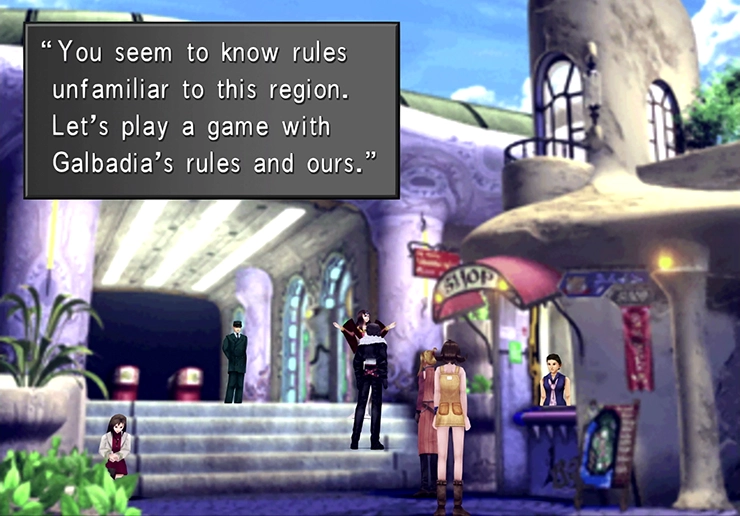
You can spread rules from region to region, but this “Basic Strategy” section of the Triple Triad guide covers the basics of the game without any additional rules, which is exactly how games are first played in the early sections of the game (in Balamb Garden and Balamb Town).
Later on, though, you will need to be aware of the rules in place for the region you are in. You can read more about these rules in the “Advanced Strategy” section below.
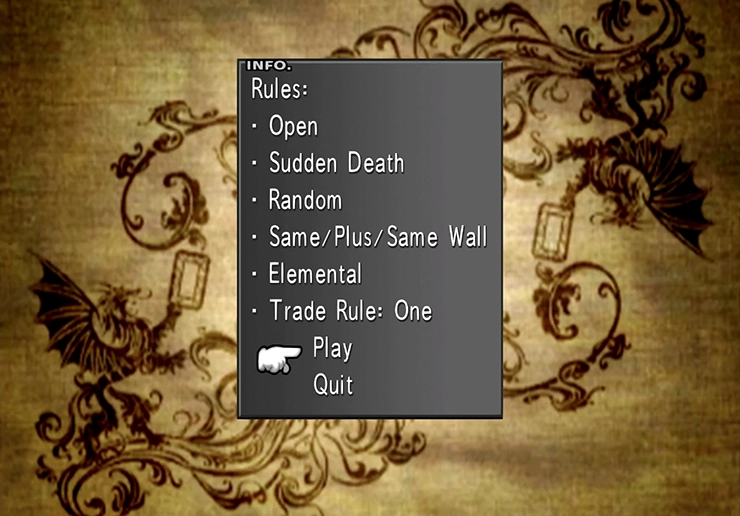
The Objective of the Game
When you lay your cards down, they will appear blue-colored on the board. When your opponent lays their cards down, they will appear red-colored, but as you and your opponent lay your cards down in each of the nine squares, you will flip the cards in the adjacent tiles if the number on the card you lay is higher than the number on the card already on the board. A demonstration of this is shown in the steps below:



You can flip more than one card at a time if the card you place on the board has a higher number than the red cards that surround it on two sides, three sides, or, if you’re really lucky, on all four sides.
1-9 and “A”
Helpful Hint
The letter “A” is equivalent to the number 10 and is, therefore, the highest possible number.
Winning Cards / Trade Rules
So, let’s say that you successfully flip over more of your opponent’s cards than they flip over yours. Let’s say that you win the game 6-4 or 7-3. Now, you get to take one or more of their cards as a prize. The amount of cards that you can win depends on the “Trade Rule” that is in place when you start the game.
The basic trade rule is “One,” which means that you will either win or lose one card, depending on whether you win or lose the game. The other trade rules are as follows:
- One: You win or lose 1 card
- Difference (Diff): You win or lose the difference between how many blue or red cards there are up. In other words, if you win six cards to four cards, you win 6-4=2 cards. If you win seven cards to three cards, you win 7-3=4 cards. If you win eight cards to two cards (or all the cards somehow), you win all the opponent’s cards. Just be wary that the reverse applies, too, and you stand to lose many cards if you lose by a lot.
- Direct (Dir): The cards that are blue and the cards that are red at the end of the match are kept by the respective team, so you keep the cards that are blue only. You should avoid this rule as you run a high risk of losing valuable cards when playing with it.
- All: You win or lose your entire hand if you win or lose the game. This trade rule makes every game a ‘high stakes’ match, but it offers the potential to win a high number of cards.
Basic Tips
Here are some basic tips to help get you started:
- Save your better cards for later on in the game, especially if you have to go first. Playing your high-level cards early gives you fewer opportunities to flip your opponent’s cards strategically.
- Don’t set your opponent up with opportunities to flip multiple cards, especially towards the end of the game. To do this, you need to place cards strategically so that your opponent can’t attack the middle of the board and hit multiple blue cards at the same time. Keep your opponent locked in.
- Be mindful of the cards that your opponent still has in their hand. Unless the “Open” rule isn’t in force, you should be considering what options your opponent has at all times. Can they flip a few of your cards if they play their cards correctly? Assume that they will, anticipate their attack, and plan defensively.
Basic Rules
Here are some of the rules that you will encounter, which are easy to deal with and don’t require any advanced strategy. Continue reading the section below for the more complicated rules.
- Open: This rule allows you to see your opponent’s cards and tends to be beneficial as it enables you to plan your strategy around what cards your opponent can potentially play. In theory, this means that your opponent can see your cards as well, but in practical
- Elemental: This rule will cause random elemental symbols to appear on the board. If the card you have has the same element as the one that appears on the board, the card will receive +1 to all four numbers. Alternatively, if the card does not have the same element as shown on the board, it will receive a penalty of -1 for all numbers. This rule is very straightforward to strategize around and does not significantly impact your odds of winning or losing a match.
- Sudden Death: If your game ends in a tie, the “Sudden Death” rule means that another game will start up, except that you will have five cards made up of the cards that were colored blue when the game ended. If there is an uneven number of blue and red cards, the remaining cards are split randomly. This rule is pretty easy to avoid but can add some complexity.
Advanced Strategy
The best strategy for getting ahead in Triple Triad is to practice, practice, practice. This Advanced Strategy section is aimed at providing more information about the more complex rules that you will come across as you progress through the game and how to deal with them.
Inspiration for this section of the guide was pulled from a post made by Reddit user u/Xiaounlimited titled “Triple Triad: Same, Plus and Combo Rules explained for newcomers,” which provided an amazing overview of the various with diagrams that have been replicated here, but full credit to Xiaounlimited for their original explanation.
Note that there are two sections specifically geared towards removing rules from certain regions. Links to these sections are below… but there are times when you will be forced to play games with the more complicated rules in place, and it’s easier to deal with these complex rules if you have a solid understanding of how they work. The details of these rules are included below.
Abolishing the Random Rule in Dollet
Triple Triad Card Game

The process that you can follow to remove the “Random” card rule in the town of Dollet.
Abolishing the Elemental Rule in Dollet
Triple Triad Card Game
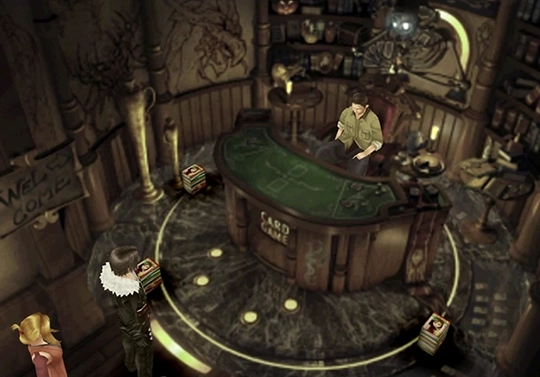
The process that you can follow to remove the “Elemental” card rule, also in the town of Dollet.
A list of the more complex rules:
Same
The “Same” rule is considered one of the easier rules to deal with, though it does involve paying a bit more attention to your card games when it is in effect. The way it works is if the card you or your opponent places on the board matches numbers on two or more sides, you will capture those cards. Refer to the illustrations for more information:



Plus
This rule makes the game a bit more complicated, but it operates similarly manner to the “Same” rule. The only difference is that, instead of comparing whether the two values are the same, you add them together. If the two values match, then you flip over both cards.



In the example above, the numbers on the bottom add up to 7 (5+2), and the numbers on the right side also add up to 7 (3+4), which triggers the “Plus” rule and flips both of the cards blue.
As you can see, this rule requires you to do quite a bit of quick math in your head. The math isn’t necessarily for you to plan for your moves, but rather, this rule makes it difficult to prepare for your opponent’s moves.
Your opponent will often trigger the “Plus” rule, and without sitting down and overanalyzing each game, line-by-line, you’re likely to be caught off guard. Therefore, it’s recommended to avoid the “Plus” rule altogether, where avoidance is a possible option, that is.
Combo
The Combo rule is where things get even more complex and yet even more straightforward. Combo does not add any additional rules per se. Instead, once you flip a card using the “Same” or “Plus” rule, the game goes through another evaluation of the Plus/Same rule as though the newly flipped cards had also been placed by you or by your opponent. Therefore, if the cards you or your opponent just flipped also trigger the “Plus” or “Same” rule, you will flip those cards as well.
The challenge with “Combo” is that it’s very hard to anticipate these complex moves ahead of time, and you will quite often be caught off guard by a massive combo on the part of your opponent taking all of your cards near the end of the game. Just know that this rule is incredibly challenging to deal with, and, in many cases, saving your game and resetting when you lose a bunch of high-level cards is your best bet.
Conclusion
And that’s it! Just remember that there’s an element of random luck in all Triple Triad games, so be sure to save your game frequently and reset the game if things get too out of hand.
